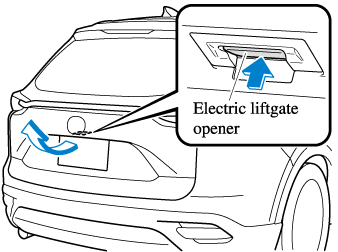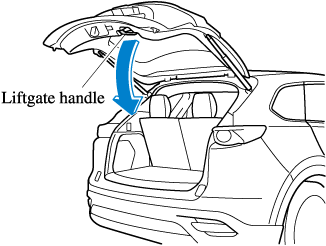

Opening and Closing the Liftgate
Opening the liftgate with Electric liftgate opener
Unlock the doors and liftgate, then press the electric liftgate opener on the liftgate and raise the liftgate when the latch releases.
For the power liftgate operation, refer to Power Liftgate (Search).

(With the advanced keyless function)
-
A locked liftgate can also be opened while the key is being carried.
-
When opening the liftgate with the doors and the liftgate locked, it may require a few seconds for the liftgate latch to release after the electric liftgate opener is pressed.
-
The liftgate can be closed when the doors are locked with the key left in the vehicle. However, to prevent locking the key in the vehicle, the liftgate can be opened by pressing the electric liftgate opener. If the liftgate cannot be opened despite doing this procedure, first push the liftgate completely closed, then press the electric liftgate opener to fully open the liftgate.
-
When the liftgate latch is released by pressing the electric liftgate opener, the liftgate raises slightly. If the liftgate is not operated for a certain period of time, the liftgate cannot be raised.
To open
Press the electric liftgate opener again.
To close
To close the liftgate from its slightly raised position, open it first by pressing the electric liftgate opener, then close it after waiting at least 1 second.
-
If the liftgate is not fully closed, the driver is notified by a warning indicated in the instrument cluster.
-
If the vehicle battery is dead or there is a malfunction in the electrical system and the liftgate cannot be unlocked, the liftgate can be opened by performing the emergency procedure.
Refer to When Liftgate Cannot be Opened (Search).
Closing the liftgate
Lower the liftgate slowly using the liftgate handle, then push the liftgate closed using both hands.
Do not slam it. Pull up on the liftgate to make sure it is secure.
For the power liftgate operation, refer to Power Liftgate (Search).

Confirm that the liftgate is securely closed.
The liftgate, move it without pressing the electric liftgate opener to verify that the liftgate has not been left ajar.




